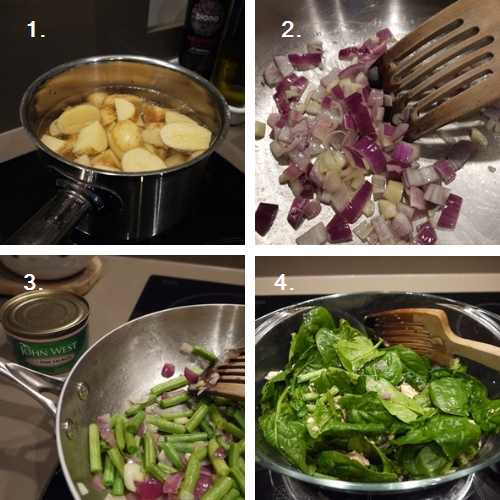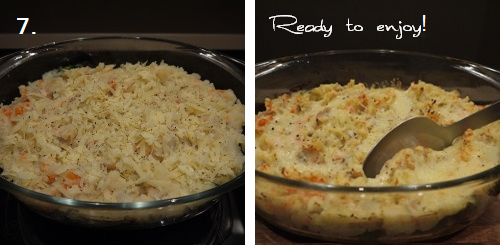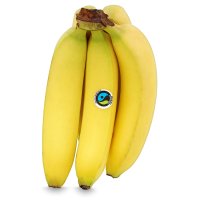 Category: Health & Nutrition
Category: Health & Nutrition
Simple Fish Pie
Welcome to my family meals where I share my favourite fresh, nutritious, easy and quick meals for the whole family to enjoy. Where possible, we always eat and cook with organic ingredients. I like to buy the freshest produce for my family to ensure we’re getting the essential vitamins and minerals we need through our food.
This Simple Fish Pie is nutritious, quick (the green beans and spinach cook in the oven) and my toddler loves it.
Serves 4
Prep Time 10 minutes. Cooking Time 25 minutes.
You’ll Need:
- 1 Red Onion
- 2 cloves of Garlic
- 8 Potatoes
- 2 Carrots
- 200g Green Beans
- 3 handfuls of Spinach Leaves
- Tin of Salmon
- 1/2 cup Milk (to help mash the potatoes and carrots)
- Sprinkle of low-fat Cheese for the topping
- Sprinkle of Pepper to taste
- Serve with Sweetcorn (I use super sweet Waitrose Organic Frozen Sweetcorn)
Let’s Make Simple Fish Pie
1. Wash and chop the potatoes and carrots. Boil until soft.
2. Chop and saute the onion and garlic in some olive oil.
3. Wash and chop the green beans into small bite sized cuts. Add to the onion and garlic for a few minutes and stir occasionally.
4. Open the tin of salmon. Add the onions, garlic, green beans, salmon and spinach into a Pyrex Dish and mix together.
5. Mash the potatoes and carrots with a little milk until you have a smooth consistency.
6. Add the mashed potato mix on top of the vegetables and salmon.
7. Sprinkle a little cheese over the potato mix and add pepper to taste.
8. Cook in the oven on fan bake at 180 degrees Celsius for 25 minutes (until potato top is turning golden).
9. Boil frozen sweetcorn for 40 seconds.
10. Serve with sweetcorn and savour this hearty and healthy meal with your family.

Food for Thought
Weaning your baby from the breast or bottle is an exciting time for you and your baby. You’re about to introduce new tastes, textures and foods that will help provide the nutrients your baby needs to develop and grow into a healthy child.
Waiting until your baby is ready to process solid food lessens the chance of developing food allergies. Health experts recommend full term babies begin weaning at six months to give baby’s digestive system time to mature. At six months babies start to need a higher level of nutrients, especially iron, which they can’t get from breastmilk or infant formula alone.
Nutritionally, babies still need breastmilk or infant formula until they’re one year old and emotionally your baby receives a great source of comfort and security from nursing.
In the beginning weaning is all about taste and exploration. For the first couple of weeks offer a teaspoon or two of solids once a day when baby is slightly peckish. Pureed pear, apple, sweet potato, parsnip and carrot are sweet tasting and gentle on baby’s tummy. Ripe banana and avocado can be mashed to achieve a smooth consistency. Baby rice and baby cereals are a good introduction to grains and can be mixed with your baby’s usual milk.
It’s beneficial to introduce foods one at a time over a few days to check for any allergic reactions. Foods that most commonly cause allergies are wheat, eggs, shellfish, milk, nuts and seeds. You should seek urgent medical help if you think your baby is having an allergic reaction.

Foods to avoid when weaning are salt, sugar and low fat foods which are nutritionally unsuitable. Honey is a source of sugar and should not be given to babies under one year as it can contain bacteria. Cow’s milk should only be used in cooking until baby is at least one year. Nuts should not be given to children under the age of five due to the risk of choking.
Let your baby lead the way. At six months I started to wean my baby with pureed fruit and vegetables and by seven months she was showing an interest in using her fingers to eat so we moved to more of a baby-led weaning approach.
Take things slowly to give you and your baby time to adjust to weaning and allow baby to enjoy a variety of foods. Weaning is an incredible developmental stage for your baby. Eat together as a family, have fun and accept things will get messy!
 Lydia Oliver – Nutritional Advisor Only Best For Baby
Lydia Oliver – Nutritional Advisor Only Best For Baby
This article was published in the March 2013 edition of Mummy and Me Magazine.
I offer one to one nutrition programmes for breastfeeding, post pregnancy weight loss, weaning, weight management and health. Contact me.
Top 5 Foods for a Good Night’s Sleep
As a parent I count my blessings each time I get a full night’s sleep, it’s enough to make me want to jump out of bed with joy in the morning. If my toddler doesn’t wake me then I’m usually lucky enough to sleep through the night. But on occasion when I just can’t drift into a slumber, whether for reasons of stress or just a plain old inability to sleep, I turn to natural foods to assist.There are some simply brilliant foods to help induce Zzz’s. These foods contain tryptophan which converts to serotonin and melatonin, the brain’s key calming chemicals. Serotonin promotes calm and melatonin helps to cause drowsiness and lower body temperature for a restful sleep. The perfect package for shut-eye.
I recommend trying one or two of these foods 90 minutes before you plan to close your eyes so your digestive system has time to process what you eat before slumber. It’s always a good idea to avoid caffeine and alcohol at least four hours before sleep and don’t go to bed when you’re either hungry or full as this will contribute to a disrupted night’s sleep.
Top 5 Foods for a Good Night’s Sleep
1. Bananas
High in serotonin and melatonin, bananas also contain potassium and magnesium which is a muscle relaxant.
2. Oatmeal
A small bowl of oatmeal contains melatonin and complex carbohydrates which can help more tryptophan get into the brain. Topped with some warm milk this is a healthy source of comfort food and if you’re slightly peckish it will keep those hunger pangs at bay.
3. Almonds
A handful of almonds contains tryptophan and magnesium to relax muscles.
4. Low-fat Cottage Cheese
Low-fat cottage cheese contains tryptophan and is a lean source of protein that will help keep your blood sugar regulated throughout the night.
5. Flaxseed
Known for their mood lifting properties. Sprinkle a couple of teaspoons of flaxseed on a small bowl of oatmeal or on a portion of low-fat cottage cheese.
If you feel like a warm drink before bed a cup of chamomile tea can help to promote calm thanks to chamomile’s natural soothing properties. If you want something a little richer a glass of warm milk contains tryptophan and calcium, known to reduce stress and stabilise nerve fibres.
Take your pick from these Top 5 Foods and see what works best for you.
Most importantly, don’t stress about not sleeping. Having a regular routine before bed will help to get your mind and body in the mood for sleep. A warm bath with some relaxing aromatherapy oils and reading a good book before bed contribute to winding down and preparing for rest.









